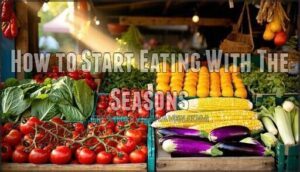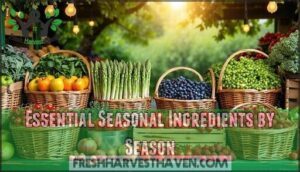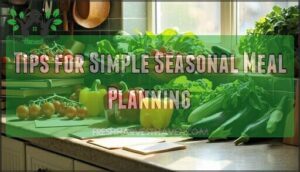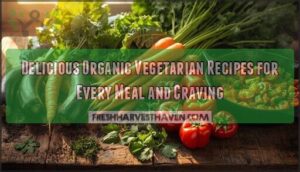This site is supported by our readers. We may earn a commission, at no cost to you, if you purchase through links.
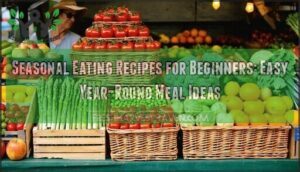
You’ll discover that spring asparagus tastes like butter, summer tomatoes burst with sunshine, and fall squash becomes comfort food magic when you cook with what’s naturally ripe.
This approach isn’t just trendy – it’s smart economics and better nutrition rolled into one delicious package.
Peak-season produce delivers triple the vitamins at a fraction of the cost, making your wallet and body equally happy.
The secret lies in simple techniques that let seasonal ingredients shine without complicated prep work, which is the key to better nutrition.
Table Of Contents
- Key Takeaways
- What is Seasonal Eating?
- How to Start Eating With The Seasons
- Essential Seasonal Ingredients by Season
- Easy Seasonal Recipes for Beginners
- Tips for Simple Seasonal Meal Planning
- Frequently Asked Questions (FAQs)
- How do you plan a meal plan with the seasons?
- How do I plan a seasonal eating journey?
- What is the best way to eat seasonally?
- How do you make the most of the season?
- What is seasonal cooking?
- Should we eat more seasonally?
- How do I know if produce is truly seasonal?
- Can seasonal eating work on a tight budget?
- What if I dislike common seasonal vegetables?
- How do I meal prep with seasonal ingredients?
- Conclusion
Key Takeaways
- You’ll slash grocery bills by up to 30% while getting triple the nutrition by choosing produce that’s naturally in season rather than expensive out-of-season imports.
- You can easily identify what’s fresh by checking farmers markets, using seasonal produce apps for your zip code, or looking for sales on abundant local ingredients at grocery stores.
- You’ll transform simple ingredients into delicious meals using basic techniques like roasting fall vegetables until caramelized or making no-cook summer salads that keep your kitchen cool.
- You can extend seasonal abundance year-round by learning simple preservation methods like freezing berries, pickling cucumbers, or properly storing root vegetables to maintain freshness.
What is Seasonal Eating?
Seasonal eating means choosing fruits and vegetables that grow naturally during each time of year in your local area.
You’ll save money, get better nutrition, and enjoy peak flavors when you eat what’s actually in season instead of relying on out-of-season imports, which allows for seasonal eating to be beneficial.
Defining Seasonal Eating
Seasonal eating means choosing fresh produce that’s naturally harvested during specific times of year in your local area.
Instead of grabbing imported strawberries in December, you’ll reach for winter citrus and root vegetables.
This approach connects you with nature’s rhythm while maximizing nutrient value and flavor.
Local sourcing becomes your secret weapon for discovering seasonal ingredients that taste better and cost less than their out-of-season counterparts.
Why It Matters for Beginners
When you’re starting out, seasonal eating feels like having a food GPS that actually works.
Instead of wandering grocery aisles confused about what to cook, you’ll know exactly what’s fresh and affordable.
These seasonal benefits make beginner cooking tips way less overwhelming.
You’ll naturally develop healthy eating habits while your food budgeting improves, since in-season produce costs up to 30% less.
It’s sustainable living made simple.
Key Benefits for Health and Budget
Here’s the core truth: seasonal eating benefits your wallet and well-being more than you’d think.
Fresh produce at peak season costs up to 30% less while packing three times more nutrients than out-of-season alternatives.
Season’s peak produce delivers triple the nutrition at 30% less cost than imports
- Nutrient Boost – Peak-season spinach contains 50% more Vitamin C than stored produce
- Budget Savings – Local seasonal ingredients reduce grocery costs substantially
- Environmental Impact – Shorter food miles cut greenhouse gas emissions dramatically
- Healthy Habits – Seasonal variety improves your microbiome diversity naturally
This approach to sustainable living transforms beginner cooking tips into healthy meal ideas that actually work for your budget and body.
How to Start Eating With The Seasons
Starting your seasonal eating journey doesn’t require a complete kitchen overhaul – just a shift in how you shop and think about ingredients.
You’ll discover that eating with the seasons becomes second nature once you know where to look for fresh, local produce and understand a few simple timing tricks.
Finding Out What’s in Season
You can discover what’s in season using simple tools that take the guesswork out of seasonal eating. Start with seasonal food guides or smartphone apps where you enter your zip code for customized local harvest lists.
The USDA and state extension websites offer free seasonal produce charts that show exactly what’s fresh in your area each month. Your grocery store’s sales and displays often feature seasonal ingredients since they’re abundant and cheaper.
Farmers’ markets clearly reflect what’s currently being harvested locally. By checking a seasonal food guide, you can make more informed decisions about the food you buy and support sustainable eating habits.
Shopping at Farmers Markets and Local Stores
Farmers markets often become your seasonal eating headquarters, where you’ll discover vibrant local produce at peak freshness.
Navigate vendors by asking about harvest dates and sustainable farming practices.
These community hubs support local agriculture while offering farm-to-table connections that grocery stores can’t match.
Store navigation becomes easier when you prioritize seasonal selections over convenience items.
By choosing produce that utilizes seasonal cooking techniques, you can create delicious and healthy meals while supporting the local economy.
Simple Tips for Beginners
Beyond simply buying seasonal produce, you’ll want to master a few Kitchen Essentials for successful seasonal eating.
Start with Meal Planning by choosing one seasonal ingredient weekly—it’s your gateway to simple recipes and stress-free Cooking Basics.
Focus on Food Safety by washing produce properly, and remember: eating seasonal doesn’t require fancy skills, just fresh seasonal ingredients and basic Grocery Shopping smarts.
Essential Seasonal Ingredients by Season
Knowing which ingredients shine each season transforms your cooking from ordinary to extraordinary.
You’ll discover that spring’s tender asparagus and sweet peas taste completely different from their out-of-season counterparts, while summer’s juicy tomatoes and berries pack flavors you simply can’t find in January, making each season’s produce uniquely flavors.
Spring: Leafy Greens, Asparagus, Peas, Strawberries
Spring brings nature’s green revival, and you’ll want to grab these nutrient powerhouses.
Leafy greens pack 100% daily vitamin K, while asparagus delivers muscle-supporting protein.
Pea shoots add sweet crunch to Green Smoothies, and strawberries bring vitamin C magic to Strawberry Salads.
These spring superstars cost 30% less in-season, making Asparagus Recipes and seasonal eating budget-friendly too.
Incorporating seasonal vegetable options into your diet can enhance the nutritional value of your meals.
Summer: Berries, Tomatoes, Zucchini, Melons, Peaches
Summer’s vibrant bounty transforms your kitchen into a flavor playground.
Berry recipes burst with antioxidants, while grilled peaches caramelize into sweet perfection.
Zucchini noodles create light summer salads that won’t weigh you down.
Melon refreshers keep you hydrated when temperatures soar.
This seasonal eating approach maximizes nutrition—fresh summer produce contains up to double the antioxidants of stored alternatives.
Exploring summer cooking tips can help you create delicious and healthy meals with the freshest ingredients.
Fall: Root Vegetables, Squash, Apples, Pears, Brussels Sprouts
As summer’s heat fades, fall brings nature’s candy: sweet apples and pears alongside earthy root vegetables.
These ingredients transform into cozy comfort food that’ll warm your soul.
- Roasted squash develops caramelized edges and creamy centers – toss butternut with maple syrup
- Brussels sprouts lose their bitter reputation when roasted with bacon until crispy
- Root vegetables like carrots and parsnips become naturally sweet when slow-roasted
Winter: Citrus, Winter Squash, Kale, Leeks, Cabbage
Winter wraps you in nature’s comfort foods.
Bright citrus recipes cut through cold days while winter squash becomes your kitchen MVP.
Kale salads with warm dressings feel surprisingly satisfying, and leek soups practically cook themselves.
Don’t overlook cabbage stews – they’re budget-friendly powerhouses.
These seasonal ingredients make cooking for beginners feel less intimidating when seasonal eating becomes second nature.
Easy Seasonal Recipes for Beginners
You’ll love how simple it’s to cook with the seasons once you try a few beginner-friendly recipes.
These easy dishes let fresh ingredients do most of the work, so you can create delicious meals without fancy techniques or complicated steps, making it easy to cook with the seasons.
Spring Recipes: Fresh Salads and Light Soups
Nothing beats the magic of fresh produce awakening your taste buds after winter’s hibernation.
Spring’s bounty transforms into vibrant seasonal salads and nourishing light soups that’ll make you feel alive again.
These spring greens pack serious nutritional punch while herb flavors dance on your palate:
- Spring Pea Risotto – creamy comfort without heavy cream
- Cucumber-Mint Soup – five-minute blender brilliance
- Asparagus Goat Cheese Frittata – beginner-friendly elegance
- Strawberry-Rhubarb Breakfast Crumble – naturally sweet morning treat
Understanding spring salad recipes is key to creating delicious and fresh meals.
Summer Recipes: No-Cook and Grilled Dishes
Beating the heat doesn’t mean sacrificing flavor—summer’s bounty makes cooking effortless and delicious.
You’ll discover that no-cook meals and simple grilling transform seasonal produce into revitalizing recipes that keep your kitchen cool while maximizing nutrition.
| No-Cook Options | Grilled Favorites | Quick Prep Tips |
|---|---|---|
| Fruit Gazpacho with watermelon | Grilled Peaches with burrata | Use precooked proteins |
| Summer Salads with corn-shrimp | BBQ vegetable kebabs | Prep ingredients ahead |
| No Cook Soups like cucumber-mint | Grilled peach and arugula blend | Keep seasonings simple |
Fall Recipes: Hearty Bakes and Roasted Meals
Fall’s bounty transforms your kitchen into a cozy haven where roasted vegetables caramelize into golden perfection.
You’ll master hearty bakes like butternut squash soup and maple-glazed Brussels sprouts that’ll make your neighbors jealous.
These comfort foods embrace seasonal eating naturally—think pumpkin risotto and apple-cranberry Dutch baby pancakes.
Fall recipes celebrate hearty stews and seasonal desserts that warm you from the inside out, featuring dishes like maple-glazed Brussels sprouts.
Winter Recipes: Comforting Soups and Warm Salads
When cold winds blow, your body craves Winter Soups and Comfort Food that’ll warm you from the inside out.
Try creamy cauliflower and leek soup using seasonal produce, or orange-glazed roasted carrots with pistachios for Salad Ideas.
These Hearty Stews and Cold Weather Meals featuring comforting soups and warm salads transform winter’s chill into cozy kitchen magic with simple soup recipes.
Tips for Simple Seasonal Meal Planning
Once you’ve got your seasonal ingredients sorted, it’s time to turn them into actual meals that’ll make your taste buds happy.
The secret isn’t complicated recipes or fancy techniques—it’s about building smart systems that work with your schedule and budget while maximizing those fresh flavors you’re paying good money for, which is the key to making the most of your ingredients and creating meals that truly satisfy, emphasizing the importance of fresh flavors.
Balancing Nutrition and Flavor
Once you’ve tried those seasonal recipes, you’ll want to guarantee each dish delivers both nutritional power and amazing taste.
Seasonal eating makes this balance easier since fresh produce naturally packs more vitamins while offering peak flavors.
Here’s how to nail the nutrient balance and flavor profiles in your seasonal meal planning:
- Pair colorful veggies with healthy fats – Think avocado with tomatoes or olive oil drizzled over roasted squash for better vitamin absorption
- Use seasonal pairings strategically – Combine iron-rich spinach with vitamin C-packed strawberries, or pair calcium-rich kale with citrusy winter oranges
- Make healthy swaps without sacrificing taste – Sub Greek yogurt for sour cream in summer gazpacho, or use cauliflower rice in fall grain bowls
Remember, eating seasonally means you’re already ahead of the game.
Those peak-season ingredients deliver maximum nutrition and flavor without any extra effort from you.
By following a seasonal meal guide, you can create a well-balanced and nutritious diet that incorporates the best of each season.
Making The Most of Fresh Herbs and Spices
Fresh herbs transform ordinary meals into flavor powerhouses.
Start with herb gardening basics—basil, mint, and parsley thrive on windowsills.
These aromatic oils intensify seasonal produce naturally.
Try botanical pairings like mint with summer melons or sage with fall squash.
Spice blending becomes second nature when you match fresh flavors to seasonal eating patterns, creating culinary inspiration that makes every dish memorable.
Storing and Preserving Seasonal Produce
Smart storage turns seasonal abundance into year-round treasures.
Store produce separately—ethylene from apples accelerates spoilage in leafy greens by 30%. Skip pre-washing; moisture increases mold rates substantially.
Try freezing methods for berries, pickling techniques for cucumbers, or dehydrating foods like tomatoes.
Proper canning tips extend shelf life twelve months, while root cellars naturally preserve seasonal ingredients without electricity. Investing in proper food containers helps maintain freshness.
Adapting Recipes to Available Ingredients
Ingredient substitutions become your cooking superpower when seasonal favorites disappear from shelves.
Recipe flexibility means swapping asparagus for green beans or spinach for kale without missing a beat.
Keep pantry staples like lentils and canned tomatoes handy—they pair beautifully with any seasonal ingredients.
Creative cooking flourishes when you view recipes as flexible frameworks rather than rigid rules, allowing for seasonal ingredients to be incorporated seamlessly.
Frequently Asked Questions (FAQs)
How do you plan a meal plan with the seasons?
Plan your meals by choosing ingredients that peak each season—spring greens, summer tomatoes, fall squashes, winter citrus.
You’ll save money, boost nutrition, and enjoy better flavors while supporting local farmers year-round, which helps in supporting local farmers.
How do I plan a seasonal eating journey?
Surprisingly, your body craves what nature provides each season—it’s not coincidence, it’s biology.
Start by shopping farmers’ markets, then gradually swap processed foods for seasonal produce that’s naturally cheaper and more nutritious year-round.
What is the best way to eat seasonally?
Start shopping locally and you’ll naturally sync with nature’s rhythm.
Buy what’s abundant at farmers markets, join a CSA, or grow your own herbs to maximize flavor, nutrition, and savings year-round.
How do you make the most of the season?
Strike while the iron’s hot!
You’ll maximize seasonal eating by shopping farmers markets weekly, preserving peak produce through freezing or canning, and trying one new seasonal recipe each week to expand your palate.
What is seasonal cooking?
Seasonal cooking means you’re using fruits and vegetables when they’re naturally at their peak ripeness and flavor. You’ll save money, get better nutrition, and taste incredible freshness.
Should we eat more seasonally?
While buying out-of-season produce might seem convenient, you’ll actually save money and boost nutrition by eating seasonally – local produce costs 30% less and contains triple the nutrients of imported alternatives.
How do I know if produce is truly seasonal?
Check your local farmer’s market and ask vendors when they harvested their crops. Look for "locally grown" signs at grocery stores, and use seasonal produce guides for your region online.
Can seasonal eating work on a tight budget?
Yes, seasonal eating saves money and works perfectly on tight budgets. You’ll cut grocery costs by up to 30% while getting fresher, more nutritious produce that tastes better too.
What if I dislike common seasonal vegetables?
Don’t let picky taste buds derail your seasonal journey.
Try roasting vegetables you typically avoid—heat transforms bitter Brussels sprouts into caramelized gems.
Experiment with familiar flavors through seasonal swaps like zucchini noodles.
How do I meal prep with seasonal ingredients?
Batch-cook grains, roast seasonal veggies, and prep proteins on weekends. Store everything separately in containers, then mix-and-match throughout the week for fresh, flavorful meals that won’t spoil.
Conclusion
Like a gardener who’s finally learned to dance with the seasons instead of fighting them, you’ve discovered the secret to eating well without breaking the bank.
These seasonal eating recipes for beginners aren’t just about saving money—they’re about reconnecting with food’s natural rhythm.
You’ll find that once you start following nature’s menu, your taste buds will thank you, your wallet will smile, and meal planning becomes second nature.
Start small, stay curious, and let each season surprise you.
- https://urbanfarmie.com/eggplant-casserole/?utm_source=msn&utm_medium=page&utm_campaign=
- http://more-resources-beyond-seasonal-meal-planning/
- https://uprootkitchen.com/tag/seasonal-produce-list/
- https://cookieandkate.com/tag/monthly-seasonal-produce-guides/
- https://mailchi.mp/healthyseasonalrecipes/healthy-seasonal-opt-in

